
A skin-tight garment is a garment that is held to the skin usually by elastic tension using some type of stretch fabric. Commercial stretch fabrics ('elastomerics') such as spandex or elastane came onto the market in 1962, and revolutionized many areas of the clothing industry. A wide variety of clothing may be made to be skin-tight, and it is common for clothing to be skin-tight for some uses, such as in stockings, bodystockings, swimsuits and women's bras.

Pajamas (US) or pyjamas (Commonwealth), sometimes colloquially shortened to PJs, jammies, jam-jams, or in South Asia night suits, are several related types of clothing worn as nightwear or while lounging or performing remote work from home. Pajamas are soft and loose garments derived from the Indian and Persian bottom-wear, the pyjamas. They originated in South Asia and were adopted in the Western world as nightwear.
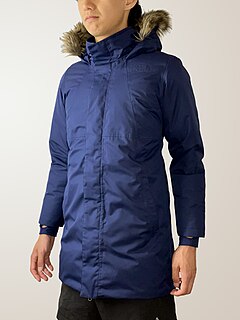
A parka or anorak is a type of coat with a hood, often lined with fur or faux fur. This kind of garment is a staple of Inuit clothing, traditionally made from caribou or seal skin, for hunting and kayaking in the frigid Arctic. Some Inuit anoraks require regular coating with fish oil to retain their water resistance.
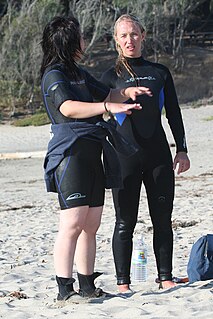
A wetsuit is a garment worn to provide thermal protection while wet. It is usually made of foamed neoprene, and is worn by surfers, divers, windsurfers, canoeists, and others engaged in water sports and other activities in or on water. Its purpose is to provide thermal insulation and protection from abrasion, ultraviolet exposure, and stings from marine organisms. It also contributes extra buoyancy. The insulation properties of neoprene foam depend mainly on bubbles of gas enclosed within the material, which reduce its ability to conduct heat. The bubbles also give the wetsuit a low density, providing buoyancy in water.

A sleeping bag is an insulated covering for a person, essentially a lightweight quilt that can be closed with a zipper or similar means to form a tube, which functions as lightweight, portable bedding in situations where a person is sleeping outdoors. Its primary purpose is to provide warmth and thermal insulation through its synthetic or down insulation. It also typically has a water-resistant or water-repellent cover that protects, to some extent, against wind chill and light precipitation, but a tent is usually used in addition to a sleeping bag, as it performs those functions better. The bottom surface also provides some cushioning, but a sleeping pad or camp cot is usually used in addition for that purpose. The bottom surface of a sleeping bag may be moderately water repellent, but a plastic tarp or groundsheet is often used to protect against moist ground.

A shirt is a cloth garment for the upper body.

A dry suit or drysuit provides the wearer with environmental protection by way of thermal insulation and exclusion of water, and is worn by divers, boaters, water sports enthusiasts, and others who work or play in or near cold or contaminated water. A dry suit normally protects the whole body except the head, hands, and possibly the feet. In hazmat configurations, however, all of these are covered as well.

A zipper, zip, fly, or zip fastener, formerly known as a clasp locker, is a commonly used device for binding together two edges of fabric or other flexible material. Used in clothing, luggage and other bags, camping gear, and many other items, zippers come in a wide range of sizes, shapes, and colors. Whitcomb L. Judson, an American inventor from Chicago, in 1892 patented the original design from which the modern device evolved.
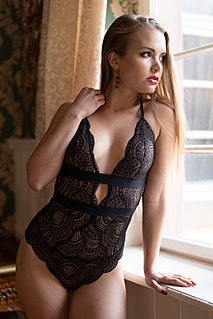
A bodysuit is a one-piece form-fitting or skin-tight garment that covers the torso and the crotch, and sometimes the legs, hands, and feet, and cannot be used as a swimsuit. The style of a basic bodysuit is similar to a one-piece swimsuit and a leotard, though the materials may vary. A bodysuit, unlike a swimsuit or leotard, has snaps, hooks or velcro at the crotch. Thong or T-front thong bodysuits usually have the crotch opening moved up to the front to underbelly area to increase the wearer's comfort. A bodysuit may have sleeves and varying shoulder strap and collar styles. Bodysuits can be made from a number of fabrics, including cotton, lace, nylon, etc. In general, textile bodysuits include expandable fiber such as spandex for a better fit to the shape of the body.
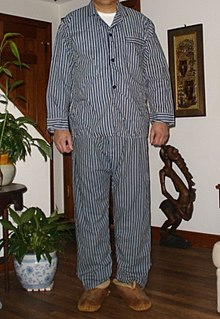
Nightwear – also called sleepwear, or nightclothes – is clothing designed to be worn while sleeping. The style of nightwear worn may vary with the seasons, with warmer styles being worn in colder conditions and vice versa. Some styles or materials are selected to be visually appealing or erotic in addition to their functional purposes.

A pillow is a support of the body at rest for comfort, therapy, or decoration. Pillows are used by many species, including humans. Some types of pillows include throw pillows, body pillows, decorative pillows and many more. Pillows that aid sleeping are a form of bedding that supports the head and neck. Other types of pillows are designed to support the body when lying down or sitting. There are also pillows that consider human body shape for increased comfort during sleep. Decorative pillows used on people, couches or chairs are sometimes referred to as cushions.

Chaps are sturdy coverings for the legs consisting of leggings and a belt. They are buckled on over trousers with the chaps' integrated belt, but unlike trousers, they have no seat and are not joined at the crotch. They are designed to provide protection for the legs and are usually made of leather or a leather-like material. Their name is a shortened version of the Spanish word chaparajos. Chaparajos were named after the chaparral from which they were designed to protect the legs while riding on horseback. Like much of western American horse culture, the origin of chaparajos was in the south of Spain, from which it then passed on to the part of New Spain that later became Mexico, and has been assimilated into cowboy culture of the American west. They are a protective garment to be used when riding a horse through brushy terrain. In the modern world, they are worn for both practical work purposes and for exhibition or show use. Chaps have also been adopted for use on motorcycles, particularly by cruiser-style motorcycle riders.
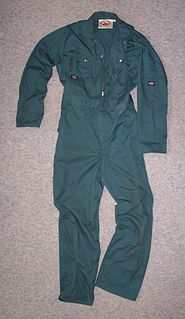
A boilersuit, also known as coveralls, is a loose fitting garment covering the whole body except for the head, hands and feet.

Competitive swimwear refers to the swimsuit, clothing, equipment, and accessories used in the aquatic sports of swimming, diving, synchronized swimming, triathlon, and water polo.

The blanket sleeper is a type of especially warm sleeper or footie pajama worn primarily during the winter in the United States and Canada. The garment is worn especially by young children.
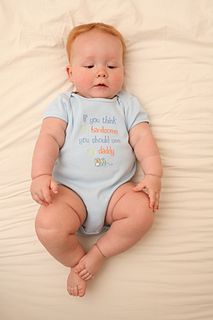
An infant bodysuit or onesie is a garment designed to be worn by babies much like a T-shirt; they are distinguished from T-shirts by an extension below the waist, with snaps that allow it to be closed over the crotch. The purpose of the opening at the crotch is to facilitate access to the infant's diaper as well as preventing the garment from riding up the infant's body and exposing skin. Like T-shirts, infant bodysuits come in a wide variety of designs and may be worn as undergarments or as outer shirts.
A layette is a collection of clothing and accessories for a newborn child. The term "layette set" is commonly used in the United States to refer to sets of baby clothes. In the 1920s, expectant mothers or their friends and relatives frequently knitted a matching layette set, consisting of a blanket, hat, sweater and booties. That tradition has continued to the present day.

The Sokol space suit, also known as the Sokol IVA suit or simply the Sokol, is a type of Soviet/Russian space suit, worn by all who fly on the Soyuz spacecraft. It was introduced in 1973 and is still used as of 2022. The Sokol is described by its makers as a rescue suit and it is not capable of being used outside the spacecraft in a spacewalk or extravehicular activity. Instead, its purpose is to keep the wearer alive in the event of an accidental depressurisation of the spacecraft. In this respect, it is similar to the ACES suit that was worn aboard NASA's Space Shuttle during launch and landing.
Sleepsacks are a type of bondage (BDSM) gear. Sleepsacks are primarily used to confine a person comfortably for an extended period of time. Similar to a conventional sleeping bag, a person climbs into a sleepsack and is usually zipped into it up to their neck. Generally sleepsacks are very tight on the body, much like mummification, which adds to the total encasement aspect of the experience.

A onesie is a type of a loose-fitting casual jumpsuit for adults made of knit cotton, fleece, or chenille. They are mostly intended as loungewear or sleepwear, but have gained significant popularity as stylish streetwear, especially in the UK and Australia, becoming increasingly popular during the late 2000s and early 2010s as a street fashion. In 2016 the onesie also appeared in Switzerland.



















